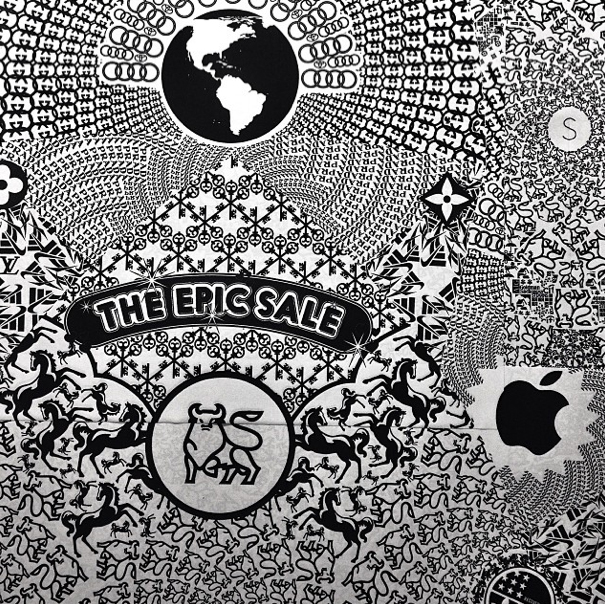Pedro Inoue
9 June – 17 August 2014
Opening night reception: 9 June, 19:30 – 21:30
| 革命はテレビ放映されないだろうが、ネット上では必ずや公開されることだろう。それはハッシュタグ、フェイスブック、ツイッターなどを経由して、ウイルス感染症のように蔓延する—国境や海を超え、政府を倒し、金融機関を揺るがし、世界秩序を塗り替える。中東の政治勢力の崩壊を伴ったアラブの春、イギリス・ベネズエラ・メキシコ・リマ・スペインの暴動、ニューヨークのウォール街・イスタンブール・アテネ・サンパウロで行われた反大企業と反権力層の傾向を持つデモンストレーションを伴った「占拠運動」など、ここ10年で多くの変化が見られた。ソーシャルメディア・インターネットミーム・スマートフォンアプリ、アサンジ・マニング・スノーデンなどの内部告発者の公表、政治的ハッカーによるサイバーテロ—これらが空気中に漂わせるのは変化の匂いである。ペドロ・イノウエは静かに身を潜めながら、この匂いを肺一杯に吸い込んでいた。
ペドロ・イノウエは長い間待っていた—政治家、大企業、軍隊、金のモチーフを頻繁に使用した社会政治的に対して明敏なグラフィックデザインを通して、噂を広め社会変化を呼びかけながら。 ブラジル出身のペドロ・イノウエは、商業デザインからアート作品まで幅広い制作を手がけながら、革命をゆっくりと企ててきた。韓国、日本、フランス、イギリスでの展示経験を有する彼は、デヴィッド・ボウイ、ダミアン・ハースト、坂本龍一などともコラボレーションをしている。またここ数年は、社会政治雑誌『アドバスターズ』のクリエイティブディレクターとしても活動している。商業的であれ芸術的であれ、彼の作品には全て、私たちが作り出した世界に対する容赦ない批判を見出すことができる。 例えば彼の素晴らしく繊細な「曼荼羅」には、目の錯覚を引き起こすような瞑想的で複雑な曼荼羅の模様が、幾百もの企業ロゴで構成されたデジタルデザインで施され、「恐怖万歳」、「軍隊&金融」、「最終セール」など機知に富んだタイトルがつけられている。曼荼羅を遠くから見ると、紙幣に印刷されている複雑な模様との関連性が思い浮かび、イメージの催眠術効果に不安と吐き気が催される。 イノウエの、幾百もの(時には幾千もの)バラバラなイメージをコラージュして複雑にまとめたデザインを生み出すグラフィック能力、そして一般に広く認識されるありふれた象徴や記号の語彙を美化する能力には、感嘆するばかりである。また身近な作品を試みた、彼のデザイン包装紙のシリーズも興味深い。美観性の高い豊富な模様を使い、サッダーム・フセイン(サッダーム)、シェル石油のロゴ(シェル)、飛行機や武器(恐怖)が描写されている。作品に近寄ると、初めてその不健全さ、隠れたサブリミナルメッセージ、皮肉が露になる。 イノウエの作品の本題のひとつとして、アーティストとお金、商業的な仕事と芸術な仕事との関係が挙げられる。過去の作品にはこの矛盾を処理しようと、高価な過程を以て限定版プリントを制作し、ランバダもしくはチバクロームを使い、アクリルとアルミニウム額を取り付けたものがある。これには、お金が飛び交う「安価な」日常から、アーティストとしての「純粋な」ビジョンを切り離す意図があった。これは完成した作品に磨きをかけるイノウエの関心、そして彼の現代美術界に対する考えにも呼応する。 東京ワンダーサイトのレジデントとして東京に滞在した際、イノウエは自分が、面白いと思っことや正しい道よりも、作品に「価値を付加する」というコンセプトに誘導されていることに気づいた。この発見により、作品を最安で制作する方法を追い求めた新たな作品シリーズの制作が促された。60年代70年代イタリアのアルテ・ポーヴェラの芸術家のように、イノウエは良質と低質の境を曖昧にし、良質な作品が安価な制作技術などの「低い」ものとは反対であるという相互関係に抵抗した考えを表した。 今回イノウエは、このコンセプトを更に掘り下げ、実際の展示スペース(壁、天井、床)の内部を全て、生地、幾何学模様、曼荼羅デザインで覆い、コンテナの空間の再創造を試みた。立体的なオブジェが一切ないにせよ、これは一種の彫刻インスタレーションとも言えるだろう。彼は、観者がインスタレーションとの相互作用から免れることのできない環境を作った—それはまるで観者に及ぼす視覚的かつ精神的なインパクトそのものが作品であるような、強要されたパフォーマンスアートのようである。
|
The revolution will not be televised, but it will most certainly be computed.It will be hashtagged, Facebooked, and Twitted. It will spread like a contagious viral disease – crossing borders and seas, toppling governments, shaking financial institutions, and changing world order.The last decade brought us the Arab Spring with its fall of political powers in the Middle East, the riots in England, Venezuela, Mexico, Lima, Spain, and the “Occupy Movement,” with its anti-corporate and anti-establishment demonstrations in New York’s Wall Street, Istanbul, Athens, and São Paulo.There is a smell of change in the air, orchestrated through social networks, memes, and smartphone apps; through the publications of whistle blowers – Assange, Manning, Snowden; and through the cyberterrorism of hacktivists. There is a smell of change and Pedro Inoue is quietly lurking, taking it all in, inhaling lungful measures of it.
He has been waiting for it for a long time, spreading the word through his socio-politically discerning graphic design, where politicians, corporations, armies, and money feature heavily, calling for a social change. His wonderful and delicately detailed Mandalas, for example, show intricate digitally-designed Mandala patterns, constructed from hundreds of corporate logos, to create a meditative patterns of optical illusion, bearing witty titles, such as, Long Live Terror, Military & Monetary, and Last Sale. Looking at the Mandalas from a distance, one immediately associates them with the intricate patterns that appear on notes, and the hypnotising nature of the images make one nauseated and uneasy. Inoue’s graphic ability to collage hundreds, sometime thousands, of separate images into convoluted cohesive designs is admiring, such as his ability to beautify such banal and commonly recognised vocabulary of symbols and signs. Also his efforts to make his works accessible through the designs of a series of wrapping papers is interesting, rich in patterns and highly aesthetic, created from a portrait of Saddam Hussein (Saddam), the “Shell” logo (Shell), or airplanes and weapons (Terror). Only a closer inspection reveals morbidity, the hidden subliminal messages, and the irony. One of the main issues arising from Inoue’s works is the relationship the artist has with money and his commercial practice, versus his practice as a fine artist. This contradiction brought in the past efforts to consolidate the two by means of expensive processes to produce limited-edition prints, using Lambda or Cibachrome, mounted in acrylic and aluminum frames. This was done to separate Inoue’s ‘inexpensive’ daily life in a capital-exchange world from his creative, ‘pure’ vision as an artist. It corresponded with Inoue’s concern for the polish of his completed pieces and his perception of the contemporary artworld. During a recent stay in Tokyo, though, as a resident of Tokyo Wonder Site, Inoue came to realize that he was letting himself be guided by the concept of “adding value” to an artwork rather than doing what he naturally thought was interesting or the right path to pursue. This revelation brought the decision to produce a new series of works where the production focuses on the cheapest way possible to execute the pieces, blurring the lines between high and low quality and defying the idea that high quality maintains a natural correlation of opposites with “low”, inexpensive production techniques, perhaps in the vein of the 60s and 70s Italian Arte Provera movement. For The Container, Inoue takes this concept further and pastes the entire insides of the physical exhibition space (walls, ceiling, and floor) with textures, optical forms and his Mandalas designs, to recreate the interior of the space. It is a sculptural installation of sorts, even though it lacks any three-dimensional objects. Inoue creates an environment in which the observer is forced to interact with the installation, a coerced performance art, where the visual, optical, and psychological impact on the viewer are the piece itself. Although immaculately planned and designed, the printing itself is inexpensive and the tiling is rough, devaluing the idea that contemporary art ought to be expensively produced. The actual “paste up” technique he employs, using wallpaper paste, also recalls street art paste ups one would see in urban landscapes, and reinforces the connection of the work with the politically driven street art for social change movement of the last couple of decades. |
